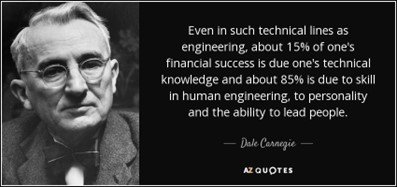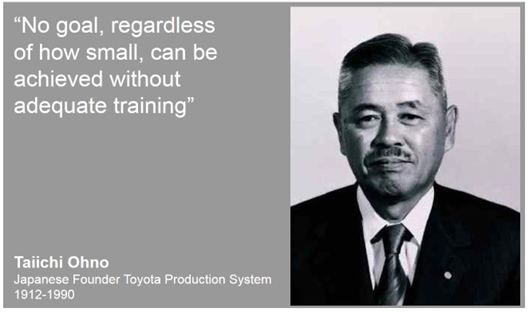What is competence
Competence is knowledge, skills, attitudes, and abilities. This is at least one definition of the term. We must deliver something to someone who needs it. We live in what we call a knowledge society, but what is the usefulness of the knowledge, if we do not have skills in carrying out processes and giving our customers efficient deliveries?
Everyone needs competence. If you only have knowledge, it means that you are not able to satisfy others than yourself, without giving anything back to society. In all companies and institutions, we have processes that can be carried out by people with different backgrounds and education. It is the processes and deliveries that are important to the customer, not the knowledge base in the institution. That means of course that one also must have access to the necessary knowledge to carry out the processes.
Developing skills is fundamental to effective processes. Through good processes, one can be trained with the support of a mentor to perform demanding tasks in an efficient manner and with high quality. If we look at the daily tasks of highly educated people, we find that they often use very little of their knowledge in their daily work. In some professions, skills are absolute central. Educating as a surgeon, for example, I guess largely must include to train on skills, in addition to knowledge development.
Examples 1.
In a hospital, I heard a lecture by a ward manager describing a case in which patients who was brought into the emergency room sometimes needed a special syringe. The syringe was important and should be put within an hour. This often resulted in critical situations because it was difficult to get an anesthetist quickly, and the patient had to wait. They decided then to train three nurses in the emergency room to follow a process where they decided that the syringe had to be put, to put the syringe and to follow up developments afterwards. Each time a syringe was injected, the anesthetist was informed, and took a visit to the patient when he got the information. Here one may think that the relevant process that consisted in putting the syringe should be carried out by a trained anesthetist. However, the hospital concluded that the most important thing was that the process was carried out correctly. This included as quickly as possible, without compromising patient safety. The employees who performed parts of this process did not have the same knowledge as an anesthetist, but they had been trained to perform the task as well as a doctor, and the patient's needs were satisfied in a better way than by having to wait a long time for the task to be performed.
Example 2.
In a company I visited once, they had a chemist who was responsible for ensuring that the quality of the product they delivered satisfied chemical requirements for the final product. This was taken care of by the chemist periodically taking samples from the production line and analyzing these in an advanced test machine. If they fell outside defined control limits, measures had to be taken. When it was asked whether it was necessary for a chemistry specialist to take these samples, it was clarified that it was not, of course. They agreed that the procedure was changed, so that the production operators took the samples, they brought them to the laboratory, they put the samples in the test machine, and if the result was within defined control limits, then the chemistry specialist did not get involved in the process at all. If the result was outside, it had to be checked further by the chemist. The chemist himself saw this as a significant improvement in the work situation, as it was relieved in everyday life and time could be used for more demanding and qualified tasks than doing routine control tasks. In this way, the laboratory's service became available to the production line, thereby effectively for the customer.
Skills
“We get brilliant results from average people managing brilliant processes – while our competitors get average or worse results from brilliant people managing broken processes.”— Fujio Cho
To develop competence, one must train on skills that make one competent to perform a task. For example, if you want to get good at playing an instrument, or practicing a sport, you practice this many hours every week. Along the way, you will need to acquire knowledge through, for example, a good Coach who follows you along the way, or that you apply to a teaching institution to acquire more knowledge about a specific topic you need. The need for knowledge then arises as a Pull effect where the person in need of the knowledge requests it.
Skills development and competence matrix
A good system for following up the team's skills is that the team has a competence arena with a competence matrix. On the matrix, the team follows up on their own skill development by listing the team's key processes and team members. Each team member defines their skill level by a scale, such as Dreyfus’ skill-scale, or a simplification of it. You then agree on the desired skill level for the team, for the individual team member and the individual key process. By training in new processes together with a mentor, often with support in an A3, the skills of the individual and the team are developed throughout the year. Continuous learning is achieved based on a Pull philosophy where the team's competence needs, in the individual process, become governing what team members train on.
Continuing education consisting of courses often leads to a focus on knowledge. You will be offered two three days off work to sit on the school bench and learn new things. The teaching is done by a lecturer who shows many PPT slides, and we may be practicing some tasks to illustrate the theory. Many course providers push such course concepts, and many HR departments measure the effect of their post-graduate training on how much money they spend by sending employees on courses. The authorities allocate money for post-education of publicly employed personnel and knowledge pushes out into society, instead of skills being developed daily, based on a Pull philosophy. Using a competence matrix with daily training provides continuous learning to a completely different degree than training plans, courses, and knowledge lifts.
What's most important?
From a few hundred cars a year in the 1950s in Toyota, development went very quickly to 1970 and beyond. They developed cars that became very popular in the market, the cars became incredibly reliable, and they used little gasoline. It was asked how Toyota could be better than the U.S. auto industry in product developments. The answer was surprising: They had too little engineers! America had an abundance of technically trained personnel, while this was a major shortage in Japan. The solution was to rethink, develop new product development procedures and working methods and train personnel with limited technical education to perform product development tasks. They trained on the skills of the tasks they needed to be able to perform, to satisfy their goals and needs.
Pull and continuous learning
If we had followed the Pull philosophy and a Pull system in continuous learning in the organization, we would have continuously focused on who needed to train on the relevant processes at all times, we would have utilized the expertise in experienced employees by acting as mentors for new employees and others in the organization, and we would develop the competence of the organization in line with the principle of continuous learning.
Why Finland’s schools outperform most others across the developed world | 7.30 – YouTube
In practice, it is often the suppliers who decide. There are HR departments that analyze an employee who is hired, based on schools that the employee has attended and results that have been achieved, as well as the HR department's own knowledge in how to select candidates for jobs. Further need for competence replenishment is often also investigated by HR managers together with courses and knowledge intermediaries where they decide large-scale training plans, continuing education programs and knowledge lifts.
In a Pull system in competence development, the employee's needs will always be in focus and developed as needed. The individual's desire and the needs of the team provide continuous learning. Trying to motivate students by setting goals for them, testing them, and controlling them for good results is a Push system that doesn't produce results.
When the school system, or the supplier, defines what we should know, and politicians try to control us towards the goal, we get a Push system where we use a lot of time to build an emergency warehouse of canned knowledge in the basement or in the attic - Just in Case.
If we have competence development based on the Pull principle, we will strive for a system of continuous development of the skills we need, when we need them - Just in Time.






